
Lignite mine
The Saint-Menge concession
The concessions
Under the reign of Charles X Philip, the search for and extraction of coal in the valleys of Vraine and Visir was resumed. Six concessions were granted by royal decree. However, after an extensive search and several explorations, coal mining only began in four concessions. These were:
La concession de Saint-Menge (Gemmelaincourt)
(1829 - 1948)La concession de Norroy (1829-1910)
La concession de la Vacherresse (1836-1890)
La concession de la Suriauville (Contrexéville) (1859-1948)
Of the four mining concessions, only the Saint-Menge concession was continuously operated industrially until 1912.

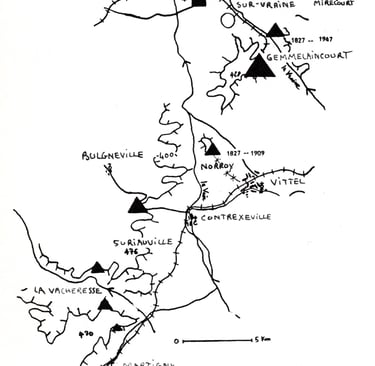
Société d'Émulation (1984). Annales de la Société d'Émulation du département des Vosges 1984. Nouvelle Série No 2. Épinal; page 88
Marc Antoine Puton
The Société Mirecourt was founded on October 2, 1826. The shareholders included merchants, lawyers, mayors, tax collectors, a doctor, a school principal, a teacher and an artist. The director of the company was Colonel Baron Puton (Marc Antoine Puton, 1779-1856). After his military career, Baron Puton turned to geometry and geology around 1816 and began to search for coal.
In 1827, the Société Mirecourt and Baron Puton began sinking the two shafts "Marchal" and "Choiseul" in Saint-Menge. Around the same time, work also began south of the Vraine at "Haye Lacroix". The shafts were initially used for probing and later for ventilation. Work began at "Le Cugnot" in 1830, which was the main mining site until 1836. After that, work concentrated on the "Chanois" area until around 1850. Due to differences of opinion, the Société Mirecourt transferred all its rights to the concession to Baron Puton in 1852. He gave up the old "Chanois" site and opened new tunnels further back in Gemmelaincourt, where favorable coal layers were found.
Emile Puton
After the death of Baron Puton in 1856, his son Emile Puton continued the work and opened a 310 meter long west-southwest adit near Gemmelaincourt. The tunnel was lined and was the starting point for further coal mining for around 20 years. In 1874, the "Hapiat" shaft was sunk on the plateau further west, marking the western boundary of the Saint Menge mine. Mining was revived in 1875 with the founding of a company. Baron Puton's daughter, the widow Malgras, was also involved in the company. Production increased steadily until the company was dissolved in 1881. Puton's heirs then took over the business.
From 1884, the Parisian engineer M. Gobat looked after the mine until he was expropriated and the mine was auctioned off in Mirecourt at nine o'clock in the morning on May 13, 1886. Emile Puton took over the mine once again. In 1889, a fire destroyed two of his warehouses containing various materials for coal mining, such as trolleys, handcarts, scales and boards. Emile Puton sold the entire mine in 1898 to Jules Bertrand, who had been director of the coal mine since 1889. He joined forces with Raymond Staub, a coal merchant from Nancy, and founded the company "R. Staub, Betrand et Cie".
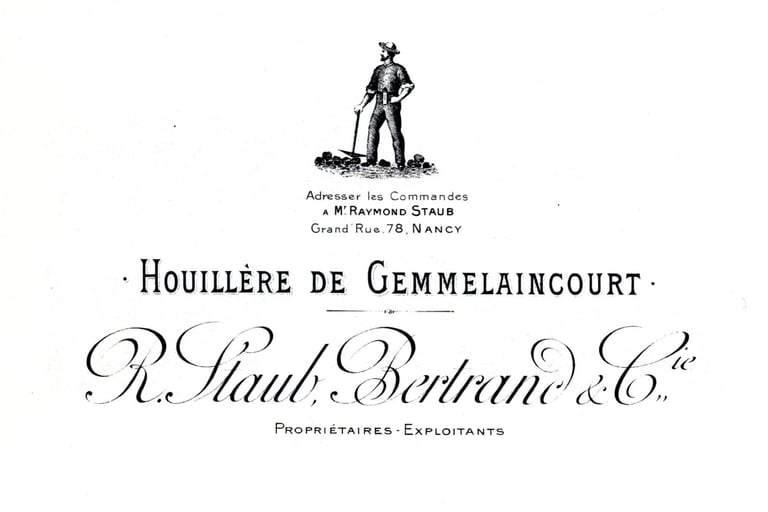

The golden age (1903-1912)
The year 1903 marked the beginning of the "Belle Époque" for the Saint-Menge coal mine, a new golden age that lasted until 1912. How did this heyday come about? Towards the end of the 19th century, the demand for glass bottles increased rapidly in the Vosges, where numerous mineral water springs and breweries were located. At the end of 1901, a group of industrialists from Nancy and the Vosges decided to build a glass factory in Gironcourt. The location was not chosen by chance, as there was a sand pit (Saint-Menge), a coal mine (Gemmelaincourt), the railroad line and the road linking Mirecourt to Neufchâteau in the immediate vicinity. The joint-stock company "Établissements de Gemmelaincourt-Gironcourt" was founded with its headquarters in Gemmelaincourt.
The task of the joint-stock company was to maintain the operation of the lignite mines of Saint Menge and Gemmelaincourt as well as the sand pit and to build a glass bottle factory. Capital of 1.5 million francs was available for this purpose. This money was used to purchase the mine and land and to build the narrow-gauge railroad and the glass factory. Around 300,000 francs remained for the operating fund. It has not been possible to determine exactly when and with what financial means the workers' housing estate with 24 apartments, an office building and the coal washing house were built. However, these investments were probably made at the beginning of the joint-stock company.
We have more information about the narrow-gauge railroad. From the late summer of 1902, newspaper advertisements were placed looking for capable quarrymen and earthworkers to build the narrow-gauge line from Gemmelaincourt to Gironcourt. The locomotive was later affectionately known as the "coucou". Its task was to collect coal from Gemmelaincourt and to load sand for the glass factory as it passed through Saint-Menge. Incidentally, the first glass bottle was blown at the glass factory in Gironcourt on March 3, 1903.
In 1911, 19-year-old Pierre Jacquemin apparently experienced a period of boredom that led to an unfortunate idea: he placed a stone in the points of the narrow-gauge railroad. This diverted "coucou" onto the siding, causing the coupler to break and the eight loaded wagons to run on at increasing speed, thanks to gravity, until they derailed after 500 meters. The culprit was quickly found. During his empty run to Gemmelaincourt, the train driver noticed the young man loitering at the points.
However, this was not the only event in 1911 that brought "coucou" into the headlines. In August, a serious accident occurred in which two horses were injured, one of them fatally. The miller from Mirecourt, Mr. Minoux, was out riding his four-in-hand. On an incline, about 600 meters from Gemmelaincourt, one of the horses was so frightened by the sudden appearance of "coucou" that it jumped directly in front of the locomotive and was killed instantly. The second horse was swept away and seriously injured, while the other two were fortunately unharmed.
Mining work in the Gemmelaincourt mine continued from the "La Presle" and "La Deuille" galleries towards the "Happiat shaft". In 1908, a new layer of coal was discovered, but the coal turned to dust and was unusable. Operations were discontinued in May 1912. More than 20,000 tons of lignite were mined each year. The cessation of coal mining was due to both the exhaustion of the site and the poor quality of the lignite.

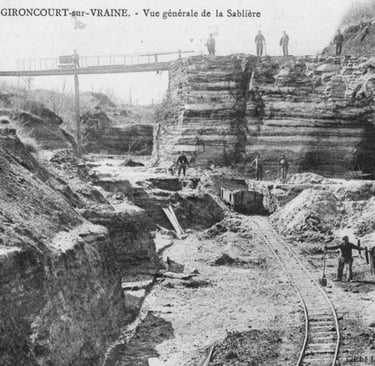
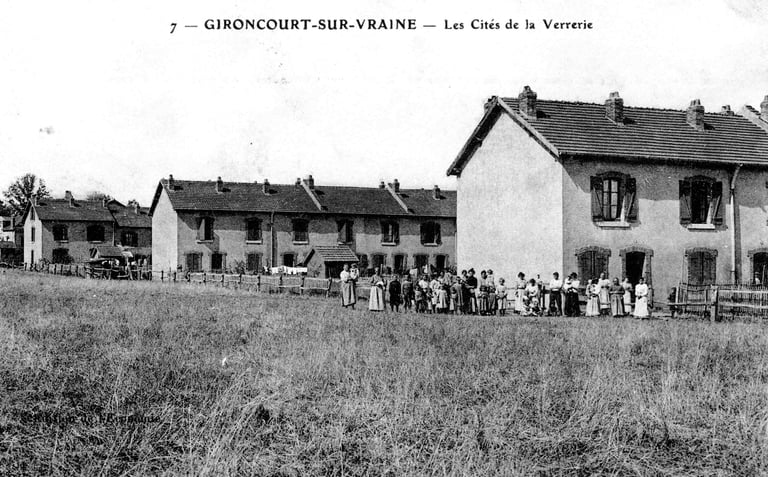

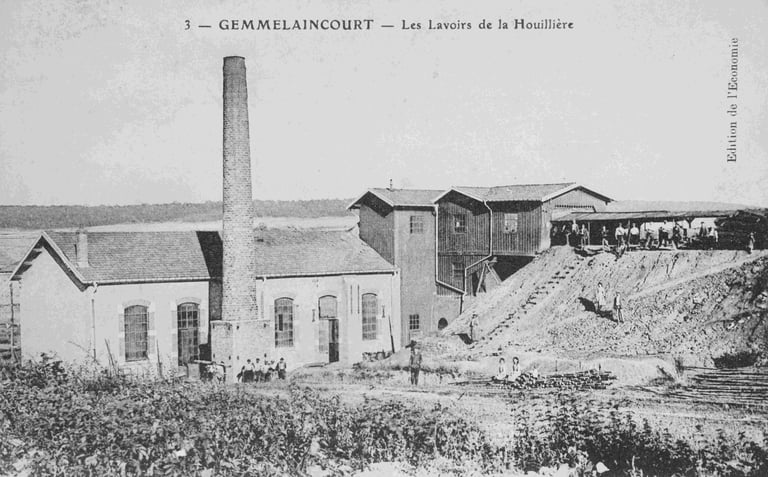

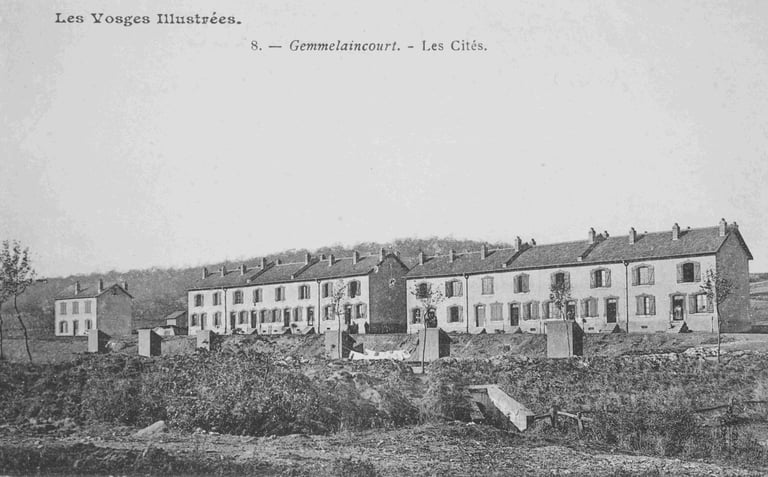

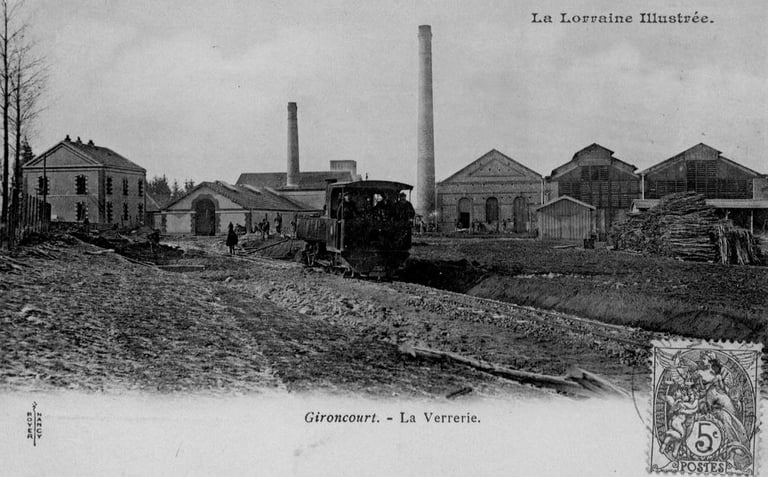

The First World War
Due to the shortage of coal during the First World War (1914-1918), Victor Sépulchre suggested resuming mining operations. As the condition of the tunnels of the old coal mine in Gemmelaincourt did not allow work to be resumed, work began in 1916 in the extreme south of the village of Saint-Menge, at "La Faubourg". At the beginning of 1919, 276 people were working in Saint-Menge-Faubourg, including a number of prisoners of war. Production slowed down in 1921 and the mine was abandoned in September 1922 as the sector was exhausted. Lignite mining in Saint-Menge-Gemmelaincourt seemed to be a thing of the past.
The Second World War (1939-1945) was to bring the importance of coal as a fuel back to the fore. On March 21, 1940, Jean Sépulchre, one of Victor Sépulchre's sons, wrote to the chief mining engineer: "In view of the growing difficulty of obtaining supplies of French and imported fuel, we wonder whether it would not be of great interest to temporarily reopen small Triassic coal plants in one or more places, taking as a model what was done here in Saint-Menge during the 1914-1918 war." In May 1941, work resumed in Saint-Menge in the "Champ de la Cure", and later also from the old tunnels in Gemmelaincourt. During the occupation, many of the workers employed in the mine escaped from the S.T.O (Service du Travail Obligatoir en Allemagne). These were difficult times, but the period after the occupation was no easier. Although freedom had been regained, there was a lack of everything, including urgently needed bicycle tires, to get to work at the Gemmelaincourt mine.
The Second World War
The End of the Saint-Menge mine
The Saint-Menge mine has been closed since 1948, after 360,000 tons of coal were extracted. One consolation remains: even though coal has not been mined in Gemmelaincourt for a long time, glass bottles continue to be produced successfully and at a high level in Gironcourt, just as in the golden age of the Saint-Menge mine.
Concession Saint-Menge

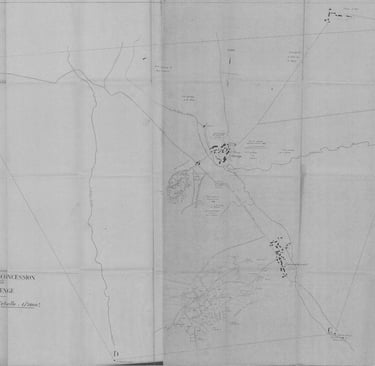
Mining took place successively
in Le Cugnot (Saint-Menge) between 1827 and 1836
in Le Chanois (Saint-Menge) between 1836 and 1850
in Gemmelaincourt between 1852 and 1912
in Faubourg (Saint-Menge) between 1916 and 1922
in the two municipalities in the 1940s
Location of the concession
Before its expansion in 1903, the Saint-Menge concession covered an area of 2,264 hectares. In the past, the boundaries of a concession were determined on the basis of landmarks such as churches, mills, road junctions and farms. This was also the case with the Saint-Menge concession. An excerpt from the description of the concession boundary: "...point A, the intersection of the axis of the road from Epinal to Neufchâteau with a straight line drawn from point D, the westernmost corner of the Happiat farm, to the easternmost corner of the gendarmerie stables in Houécourt (last building on the eastern edge of the village) ..."
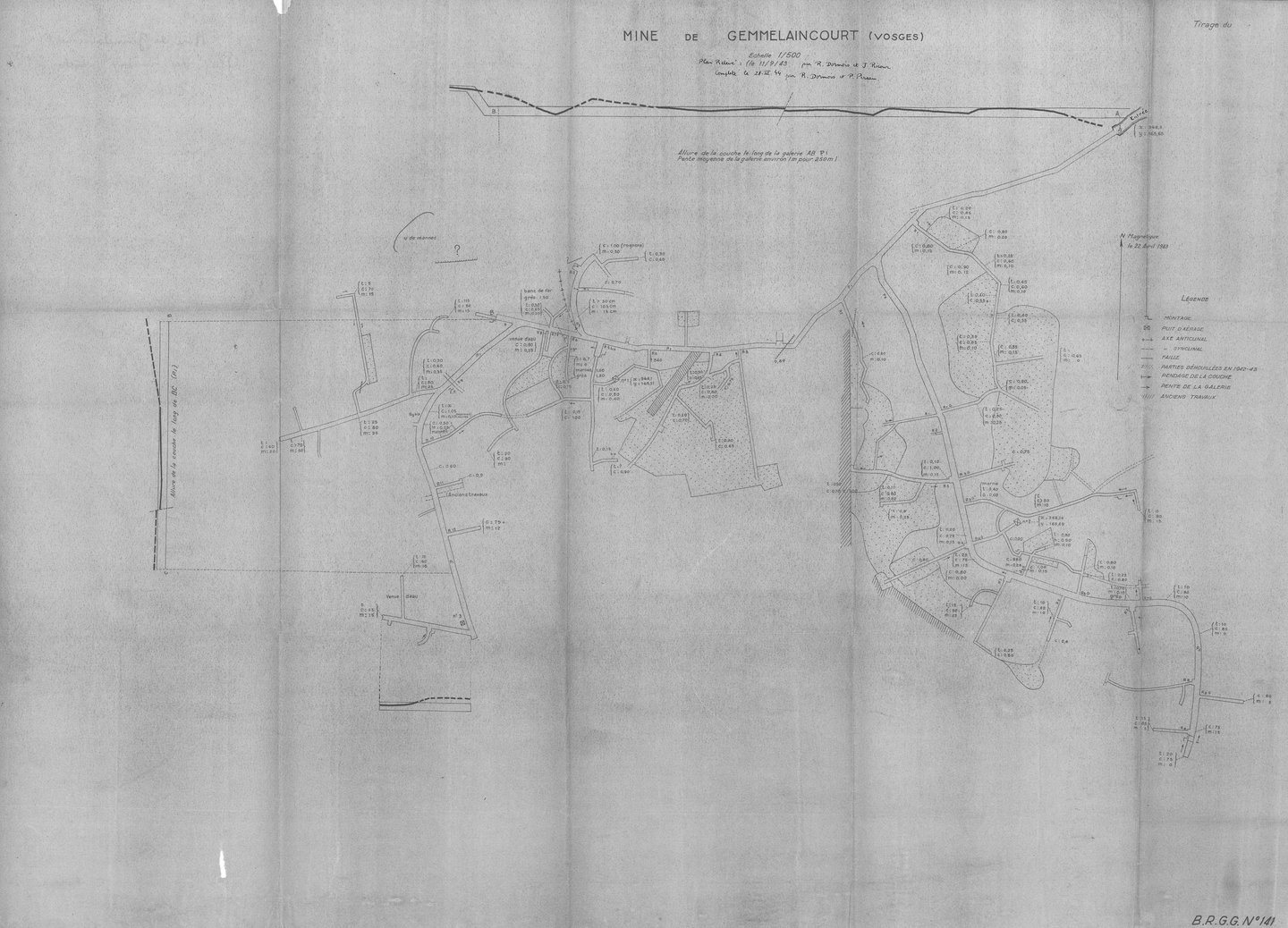

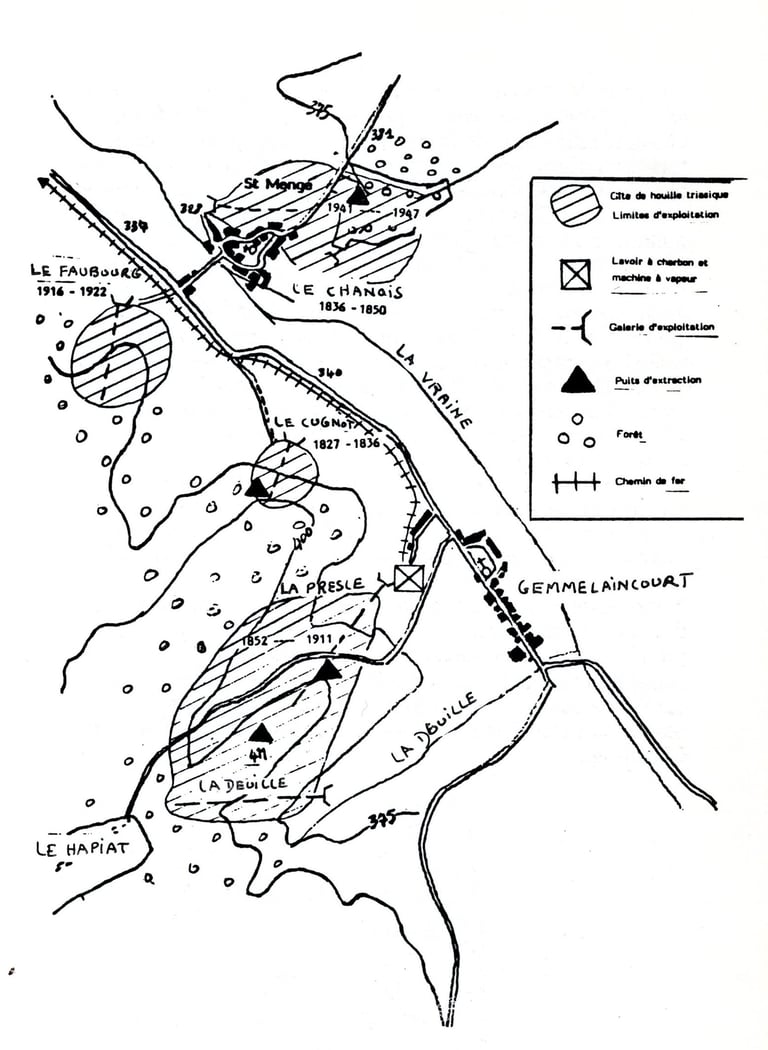

Société d'Émulation (1984). Annales de la Société d'Émulation du département des Vosges 1984. Nouvelle Série No 2. Épinal; page 91
SOURCES
"Annales de la Société d'Emulation du Département des Vosges", Epinal 1984
bassin-minier-regis.jimdofree.com
books.google.com
bul-animation-tourisme.fr
commons.wikimedia.org
fr.wikipedia.org
gallica.bnf.fr / Bibliothèque nationale de France
gironcourtsurvraine.fr
gironcourt.net
savoir.fer.free.fr
Short texts
15 March 1903, l'Abeille des Vosges
An investigation was opened against two miners, Edmond Bichet and Camille Thiriet, for having fished with dynamite during the night.
25 May 1911, l'Abeille des Vosges
The director of the "Établissement de Gemmelaincourt-Gironcourt", who was prosecuted for discharging turbid water into the Vraine stream, is sentenced to a fine of 20 francs.
16 January 1908, l'Abeille des Vosges
Working in the mines was not without danger. An accident that occurred on January 16, 1908 bears witness to this. 31-year-old Jean Ternoire was in a tunnel when a block of marl came loose from the ceiling and hit him on the right side. He complained of severe pain in his loins and abdomen and died three hours later.
13 September 1891, l'Abeille des Vosges
Mr. Charles Aubert, 61 years old, domestic servant of Mr. Voilgue, coachman, had gone to Gemmelaincourt to fetch coal with a heavy wagon drawn by three horses. On the return journey, he wanted to sit on the winch while the vehicle was moving because he was tired. He fell in front of the wheel, which crushed his legs. Aubert was taken home in the car of Mr. Romain, a grocer from Domjulien, and died four days after the accident.
CONTACT
Le Jadin des Lys
8 rue de la Fontaine
88170 Gemmelaincourt
info@gemmelaincourt.com
Legal Notice & Privacy Policy
